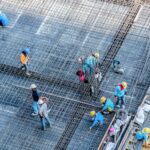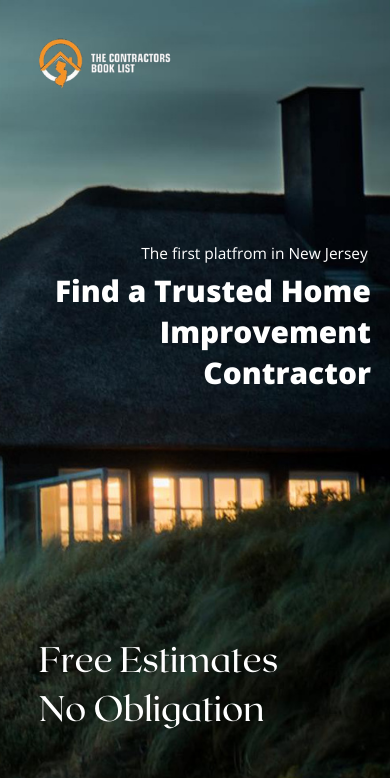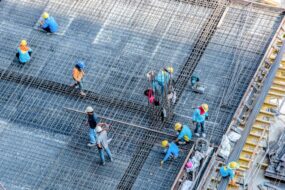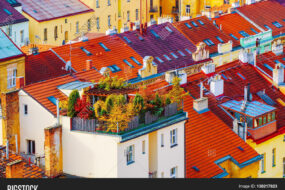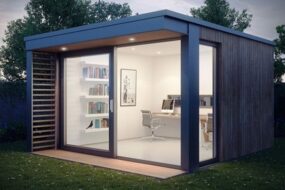
When it comes to the best roof materials that cater to the diverse needs of residential structures, prioritizing durability and longevity, three standout options are composite shingles, standing-seam metal, and built-up (BUR) roofing. However, the spectrum of roofing choices doesn’t end there. Wood shingle and shake roofing infuse homes with natural beauty. Clay or cement tile roofing boasts an impressive lifespan of 50 to 100 years.
Table Of Content
- Composite Asphalt Shingle Roof: One of the best roof materials
- Standing-Seam Metal Roof: A Durable Shield Against the Elements
- Built-Up Roofing (BUR): A Robust Layered Solution
- Asphalt Roll Roofing: A Convenient, Short-Term Solution
- Wood Shingle Roof: A Timeless and Traditional Choice
- Wood Shake Shingle Roof: A Rugged Blend of Beauty and Resilience
- Clay or Cement Tile Roofs: A Timeless Endurance of Strength and Elegance
- Slate Roof: Enduring Elegance Carved in Stone
- Membrane Roofing: Streamlined Shield for Low-Pitch Roofs
Slate outshines them all with a remarkable longevity of up to a century, albeit being a premium choice available in select regions. Additionally, asphalt roll roofing is a wallet-friendly, quick solution for DIY enthusiasts, ideal for covering sheds or porch roofs. In this post we are going to focus on the most important aspects of roofs as an investment in your home improvement project.

Exploring the realm of roofing materials unveils an array of options, each with its own set of advantages. At the forefront, we find composite shingles—a readily available, cost-effective choice boasting a moderate lifespan of 15 to 40 years, typically falling within the 20 to 25-year range. Composite shingles come with pitch considerations, requiring a minimum pitch of 2:12, while a steeper 4:12 pitch is ideal. Another contender, standing seam metal roofing, shines in fire resistance and longevity.
Although it doesn’t render a house fireproof, it can endure for 30 to 50 years with proper upkeep and swift seam repairs. For flat or nearly flat roofs, the spotlight turns to built-up roofing (BUR). Comprising layers of roofing felt, fiberglass, and hot tar (bitumen), BUR is the go-to solution, ensuring reliable protection in these specialized scenarios.
Composite Asphalt Shingle Roof: One of the best roof materials
The landscape of roofing materials is crowned by the popularity of composite shingle roofing, gracing over 80 percent of homes. These shingles come in two varieties: organic and fiberglass, both enriched with asphalt. The underside is asphalt-coated, while the exposed surface is adorned with slate, schist, quartz, or ceramic granules.
This roofing choice is celebrated for its budget-friendly nature, seamless installation, and respectable longevity. While professional crews often handle installations, adept DIYers can also undertake the task.
Anticipating the Future Composite asphalt shingles can endure for 15 to 40 years, with life expectancy varying based on material quality. Some shingle roofs even extend their lifespan to 50 years. Notably, manufacturers such as Owens Corning, GAF, and Certainteed offer premium warranties that span half a century.
To maximize asphalt shingle roofs’ lifespan, opt for quality shingles and avoid walking on them. Maintain them free from moss and refrain from power washing.
Installation Investment and Long-Term Value Typically, installing asphalt shingle roofs averages around $5 per square foot, encompassing a range dependent on shingle types and regional labor costs.
For instance, a 2,000-square-foot home with a standard roof slope translates to approximately 2,200 square feet of roof space. For professional installation, the cost hovers around $11,000. Over a century, assuming the roof undergoes replacement three to four times, the cumulative expenditure for an asphalt shingle roof falls between $33,000 and $44,000 in current dollars. Given the average homeowner’s residence span of 30 to 40 years, during which a single reroofing might occur, asphalt shingles emerge as an economically prudent roofing choice.

Standing-Seam Metal Roof: A Durable Shield Against the Elements
Amidst a growing demand, standing-seam metal roofs have ascended as a favored roofing choice, particularly in regions prone to wildfire threats. These roofs consist of substantial steel panels that overlap on the roof deck, forming raised ridges that run vertically across the roof slope.
Crafted from materials like steel, aluminum, copper, and zinc, standing-seam metal roofs present a virtually maintenance-free and robust solution, although susceptibility to dents prevails. Their installation, however, necessitates professional expertise.
Anticipating the Future With an anticipated lifespan of 30 to 50 years, standing-seam metal roofs remain a relatively recent entrant in the market, with ongoing data collection. Under optimal conditions, these roofs could surpass 75 years. To optimize longevity, regular inspections are essential, ensuring that fasteners, sealants, and panels remain intact.
Installation Investment and Long-Term Value Installation expenses for standing-seam metal roofs generally average around $10 per square foot for steel or aluminum, $13 per square foot for zinc, and $18 per square foot for copper. For instance, outfitting a 2,000-square-foot home with a steel panel roof carries an average national cost of approximately $22,000.
Interestingly, evolving metal roofing technology suggests that these roofs might consistently endure for 50 years. Assuming a single replacement, total costs over a century stand at $44,000 in current dollars.
Unveiling the Best Value For homeowners residing in a house for 30 to 40 years before selling, a solitary $22,000 re-roofing expenditure could potentially suffice if opting for metal roofing. Prospective home buyers might discover a significant advantage in purchasing a home with a metal roof, negating the need for future re-roofing projects. In several respects, standing-seam metal roofs present a financially astute alternative to the conventionally favored asphalt shingle roofs.

Built-Up Roofing (BUR): A Robust Layered Solution
Built-Up Roofing (BUR) presents a multi-layered roofing method, achieved by interchanging layers of roofing felt and waterproof components like fiberglass, sealed with hot tar (bitumen). Commonly selected for flat or gently sloped roofs, BUR roofing boasts fire resistance and cost-effectiveness, albeit the installation process can be odorous.
Anticipating Longevity A typical BUR roof maintains a lifespan ranging from 20 to 30 years. Prolonging the roof’s lifespan entails regular maintenance, prompt repairs, and shielding the roof surface from debris to prevent wear and tear.
Installation Costs and Long-Term Value The average expense for installing built-up roofing hovers around $4 per square foot. In the context of a 2,000-square-foot house sporting a roof size closely aligned with that square footage, the mean professional installation cost stands at approximately $8,000. Assuming the necessity for roughly four replacements over a span of 100 years, roofing expenses in current currency amount to roughly $32,000 over the century.
It’s important to note that this roofing type is not suited for homes with noticeable roof slopes, making proper suitability paramount.

Asphalt Roll Roofing: A Convenient, Short-Term Solution
Asphalt roll roofing employs large rolls of the same material used in conventional asphalt shingles. Suited for relatively level pitches, such as inclined shed roofs, this type of roofing is installed by positioning strips lengthwise across the roof in overlapping layers.
While asphalt roll roofing can be relatively easy for DIY installation, it finds its best applications in structures like sheds, garages, and occasionally porch roofs, rather than being an optimal choice for most residential roofs.
Anticipating Longevity The anticipated lifespan of asphalt roll roofing typically ranges from 5 to 10 years at most. Extending the roof’s longevity largely depends on regular maintenance to keep it debris-free and promptly repairing any punctures or damage.
Installation Costs and Long-Term Value Given its suitability for roofs with a relatively level apex, a 2,000 square foot house will have nearly 2,000 square feet of roof area.
Average installation costs for this type of roofing average around $2.25 per square foot, resulting in an approximate total cost of $4,500. However, considering the likelihood of replacing this roofing about 12 times over a century, overall expenses in present-day currency could reach as high as $54,000 over the course of 100 years.

Wood Shingle Roof: A Timeless and Traditional Choice
Crafted from thin, wedge-shaped segments of natural wood, such as cedar or yellow pine, wood shingle roofs exude an alluring charm. These shingles are meticulously sawn from logs and create an exceptionally attractive roof. However, their installation can be intricate and is generally not recommended for most do-it-yourself enthusiasts. It’s crucial to note that escalating fire risks in certain regions have led to legal constraints on the use of wood roofing materials, making them unsuitable in areas prone to seasonal wildfire hazards.
Anticipated Lifespan The average lifespan of wood shingle roofs spans approximately 25 to 30 years. In locations characterized by gentle conditions and minimal debris accumulation, these roofs may endure even longer, reaching up to 50 years when diligently maintained. To maximize the longevity of a wood shingle roof, immediate replacement of split or cracked shingles is imperative, alongside keeping the roof free from moss growth.
Installation Costs and Long-Term Value In comparison to asphalt shingles, wood shingles are pricier, ranging between $6.50 and $11.00 per square foot, including installation. Assuming an average cost of about $9 per square foot, a 2,000 square foot house with a standard sloped roof area of 2,200 square feet will necessitate an approximate investment of $19,800 for roofing. Considering that this roof may require replacement three to four times within a century, projected expenses could range from $60,000 to $80,000 over the span of 100 years, calculated in today’s monetary terms.

Wood Shake Shingle Roof: A Rugged Blend of Beauty and Resilience
Distinguished by their thicker composition compared to wood shingles, wood shakes emerge as a sturdier option that better withstands the rigors of weather and UV rays. These shakes boast enhanced durability and longevity, making them a reliable choice for homeowners seeking both aesthetics and robustness. However, installing wood shakes is a task best left to professionals, as their intricacies require expert handling. It’s important to note that, similar to wood shingles, the use of wood shakes may be limited in regions prone to wildfires.
Predicted Lifespan Wood shake roofs typically offer a lifespan of 35 to 40 years, with instances of even longer durability not uncommon. Prolonging their lifespan entails meticulous care and maintenance. While wood roofing materials don’t allow for maintenance-free living, adhering to best practices can significantly extend their viability. Promptly remove debris settling on the roof’s surface, eradicate moss growth, and replace split or damaged shakes without delay. Addressing curled, cupped, or split shakes immediately is crucial to sustaining the roof’s integrity.
Installation Costs and Long-Term Value Both the materials and installation expenses associated with wood shakes exceed those of wood shingles. Generally, you can anticipate wood shakes to cost around 50 percent more than shingles.
Assuming an estimated cost of $13 per square foot, a 2,000 square foot residence with a sloped roof area of 2,200 square feet will command a $26,000 investment for installation. If the roof necessitates three installations over the course of a century, average expenses in today’s monetary terms would amount to $78,000 over 100 years.
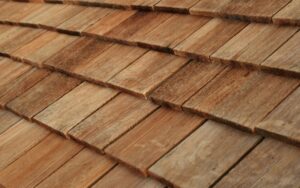
Clay or Cement Tile Roofs: A Timeless Endurance of Strength and Elegance
Clay and cement tile roofs have garnered immense popularity in the Southwestern United States, although their appeal extends across the nation due to their remarkable robustness and durability.
Typically fashioned from terracotta clay, these roofs also encompass ceramic tiles (crafted from fired clay) and concrete tiles. Regardless of composition, all variants involve individual tiles arranged in overlapping layers across the roof’s expanse. Each type offers similar levels of sturdiness and longevity, demanding a resilient roofing structure capable of bearing their weight and necessitating the expertise of skilled professionals for installation. With proper care, this might very well be the sole roof your home will ever require.
Predicted Lifespan Clay and cement tile roofs exhibit a consistent tendency to endure for a century or more when properly tended to. Unlike wood shake or shingles, which succumb to decay, or composite shingles, which shed mineral grains gradually, tile roofs’ chief vulnerability lies in cracking.
Avoid walking on your tile roof as much as possible. To counteract efflorescence often encountered with terracotta, gently buff it away with a dry, clean towel. Apply a clear alkyd primer to coat the tiles. Immediately replace cracked or broken tiles upon detection.
Installation Costs and Long-Term Value Costs fluctuate significantly based on whether the tiles are traditional clay terracotta, fired ceramic, or concrete. Concrete tiles may demand around $10 per square foot for installation, terracotta costs may span $15 to $20 per square foot installed, while ceramic tiles can range from $20 to $30 per square foot installed. Assuming installation of a traditional Spanish clay tile roof at $20 per square foot, expenses for a 2,000 square foot dwelling with 2,200 square feet of sloped roof area would total $44,400.
Nonetheless, given the highly probable century-long lifespan, expenses in today’s currency would remain constant at $44,000 over a span of 100 years. Opting for a tile roof not only serves the interests of future occupants but also establishes a prudent choice. Moreover, while seeking a new residence, a tile roof under 50 years old might signify a home that will never necessitate re-roofing.

Slate Roof: Enduring Elegance Carved in Stone
Slate roofing stands as a distinguished variation of stone roofs. Rather than being molded from clays or concrete, slate roofs are adorned with genuine stone hewn from quarried rocks. The natural propensity of slate to split into flat slabs renders it an ideal choice for adorning rooftops.
Expert artisans must install slate, turning it into both the most costly and the most enduring of common roofing materials. With proper care, it has the potential to outlast the lifespan of your home—even spanning two centuries. Given its expense, slate is typically reserved for grand, opulent residences.
Anticipated Lifespan A slate roof can effortlessly withstand 100 years or more, and even beyond. Remarkably, slate roofs in operation today can trace their origins back hundreds of years. To sustain this extraordinary longevity, promptly replace any broken slate tiles and ensure all flashings are meticulously installed and well-functioning. As copper flashings blacken, it’s a clear signal to arrange their replacement.
Installation Costs and Lifetime Value Slate roof costs exhibit substantial variation, ranging from approximately $10 to as high as $75 per square foot, including installation.
Assuming an average installation cost of $30 per square foot, a residence covering 2,000 square feet with 2,200 square feet of sloped roof area might entail a cost of about $66,000 for slate roofing.
Nevertheless, this marks the only expenditure required. Besides maintenance and potentially significant repairs, a well-constructed slate roof should necessitate replacement only after a century or more. Therefore, while the initial cost of a slate roof installation might appear high, it proves reasonable when spread across the expanse of many decades.

Membrane Roofing: Streamlined Shield for Low-Pitch Roofs
Commonly known as rubber roofing, membrane roofing closely resembles rolled asphalt roofing in its large sheet form. While shingle-type roofing excels at repelling water, expansive sections of membrane materials combat water infiltration by minimizing seams.
This roofing option is particularly well-suited for flat or low-pitch roofs. Prominent choices for membrane roofs encompass neoprene, EPDM, and PVC.
Installation typically costs around $5 to $10 per square foot for membrane roof material. As long as the membrane maintains its water resistance, it can endure for approximately 20 to 35 years before necessitating replacement.
Selecting the Right Roofing Materials Opting for budget-friendly alternatives might seem attractive when faced with the immediate need to replace a worn-out roof. However, a forward-thinking approach reveals that investing in pricier roofing materials can yield superior value over your home’s lifespan. Standing seam metal or even slate roofing offer superb choices for enduring, long-term solutions. When considering the overall cost, these materials can prove to be the most economical, especially if you can manage the initial installation expense.
Ready to take the next step in finding the perfect roofing material for your home? Head over to our platform to discover more options and connect with trusted contractors!



